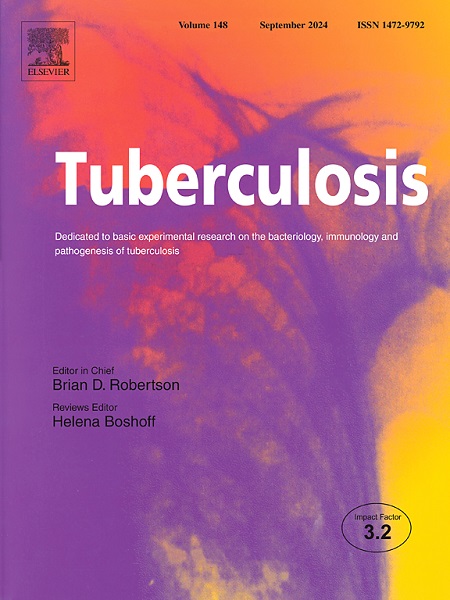中非共和国耐利福平结核分枝杆菌复合体基因组多样性和传播集群的快照
IF 2.9
3区 医学
Q3 IMMUNOLOGY
引用次数: 0
摘要
结核病是中非共和国的一个重大公共卫生问题,缺乏对该国人群中流行的结核分枝杆菌复合菌株的全基因组鉴定和分型。在这里,我们调查了2024年从班吉8个区及周边地区收集的68株利福平耐药临床分离株。所有分离株均为严格感结核分枝杆菌,分布在9个谱系:L4.1.2.1 Haarlem (n = 20)、L4.6欧美(n = 17)、L4.6.1.2乌干达(n = 13)、L4.6.2.2喀麦隆(n = 12)和L4.1.1.1 x型(n = 2), L4.1欧美、L4.6.1乌干达、L4.3.1 LAM和L3德里- cas。耐药谱显示,9/68株(13.2%)结核分枝杆菌敏感,59/68株(86.7%)至少表现出一种预测耐药。与邻国的报告相比,这些数据为中非共和国的结核病传播提供了新的见解,包括没有牛分枝杆菌,因此没有人畜共患结核病和其他因素。然而,这项初步研究仅限于对利福平耐药的分离株,为中非共和国开展基于基因组的结核病调查铺平了道路,这对于加强对致命结核病的管理和控制至关重要,结核病是该国的一个公共卫生问题。本文章由计算机程序翻译,如有差异,请以英文原文为准。
A snapshot of genomic diversity and transmission clusters of rifampin-resistant Mycobacterium tuberculosis complex in the Central African Republic
Tuberculosis, a significant public health concern in Central African Republic lacks whole-genome-based identification and typing of the Mycobacterium tuberculosis complex strains circulating in populations in that country. Here, we investigated 68 rifampin-resistant clinical isolates collected in 2024 from eight districts in Bangui and surrounding regions. The analysis revealed that all isolates were M. tuberculosis stricto sensu, distributed across nine lineages: L4.1.2.1 Haarlem (n = 20), L4.6 Euro-American (n = 17), L4.6.1.2 Uganda (n = 13), L4.6.2.2 Cameroon (n = 12), and L4.1.1.1 X-Type (n = 2), and single isolates in L4.1 (Euro-American), L4.6.1 (Uganda), L4.3.1 (LAM), and L3 (Delhi-CAS). The antibiotic resistance profile showed that 9/68 (13.2 %) of the M. tuberculosis isolates were susceptible, while 59/68 (86.7 %) exhibited at least one predicted antibiotic resistance. These data provide new insights into tuberculosis transmission in Central African Republic in contrast to reports from neighboring countries, including the absence of Mycobacterium bovis, hence zoonotic tuberculosis and other factors. This preliminary study limited to rifampin-resistant isolates, nevertheless paves the way for a genome-based survey of tuberculosis in Central African Republic which is essential for enhancing the management and control of the deadly tuberculosis that is a public health concern in the country.
求助全文
通过发布文献求助,成功后即可免费获取论文全文。
去求助
来源期刊

Tuberculosis
医学-呼吸系统
CiteScore
4.60
自引率
3.10%
发文量
87
审稿时长
49 days
期刊介绍:
Tuberculosis is a speciality journal focusing on basic experimental research on tuberculosis, notably on bacteriological, immunological and pathogenesis aspects of the disease. The journal publishes original research and reviews on the host response and immunology of tuberculosis and the molecular biology, genetics and physiology of the organism, however discourages submissions with a meta-analytical focus (for example, articles based on searches of published articles in public electronic databases, especially where there is lack of evidence of the personal involvement of authors in the generation of such material). We do not publish Clinical Case-Studies.
Areas on which submissions are welcomed include:
-Clinical TrialsDiagnostics-
Antimicrobial resistance-
Immunology-
Leprosy-
Microbiology, including microbial physiology-
Molecular epidemiology-
Non-tuberculous Mycobacteria-
Pathogenesis-
Pathology-
Vaccine development.
This Journal does not accept case-reports.
The resurgence of interest in tuberculosis has accelerated the pace of relevant research and Tuberculosis has grown with it, as the only journal dedicated to experimental biomedical research in tuberculosis.
 求助内容:
求助内容: 应助结果提醒方式:
应助结果提醒方式:


